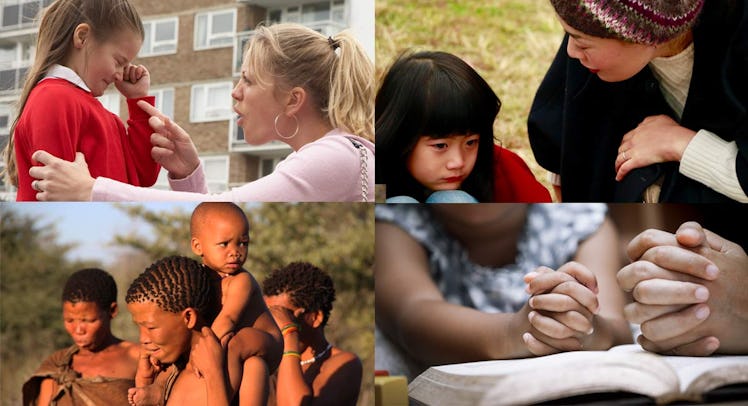Child Rearing Discipline Practices Across Cultures
Every parent wants their child to be successful, but how to ensure a kid develops good behavior is based on cultural context.

All parents can agree that the purpose of child rearing and discipline is to help a kid become a successful, prosocial member of society. But the way a parent raises a child to reach the apparently universal goal of becoming an upstanding member of their community is largely based on cultural norms. Depending on where a child is born on the globe, the cultural norms for parenting may be rooted in traditions that go back thousands of years. In other parts of the world, the norms are more dynamic and change with the tide of public opinion. But whether a parent offers stern guidance, or focuses on a kid’s autonomy, all parents can agree that the kids future is what drives the way they praise and punish.
READ MORE: The Fatherly Guide to Parenting in Other Countries
Europe and the Ban on Corporal Punishment
The biggest trend in European child discipline is the move to make spanking, striking, or slapping a child illegal. The push for corporal punishment bans has largely been led by the human rights organization The Council of Europe. The organization proposed the ban in 2009 and it has since been ratified by more than 23 countries. France was the most recent country to outlaw spanking, passing a law to end the practice in 2016. Sweden, on the other hand, was a pioneer of such bans, passing a law to end spanking as early as 1979.
This is not to say that there is no discipline in European countries. It’s true that many parents prefer to emphasize their child’s autonomy by allowing them to make mistakes and learn from them. However, the French, for instance, are notoriously icy in their dealings with the children, preferring that they not interrupt adults and making sure that children understand their place, often bluntly and verbally. Germans, likewise, have a tendency to lean into harsh verbal corrections in extreme circumstances.
Britain and the Naughty Step
The Brits have seen a big push in discipline that leans on positive parenting. In other words, British parents have been moving toward gentle praise and encouragement, rather yelling or hitting their children when disciplining. Some of this may be due, in part, to the rise of the “supernanny” style of parenting which focuses on the importance of interaction and praise, along with the use of timeouts on the “naughty step” in order to give children a moment to think about their behavior.
That said, child discipline in Britain is as fraught as it is in the United States, with many parents worried about being too strict or too lax when it comes to children misbehaving.
The United States and the Evangelical Rod
Discipline in the United States is as diverse as the parents who populate the country from sea to shining sea. However, the United States is unique in the world in its view towards corporal punishment. As recently as the 1980s, above 90 percent of the population believed that spanking a child was a reasonable form of discipline. While that number has fallen to around 70 percent, there are still many places in the U.S. where a child can even be paddled in school for bad behavior.
Much of acceptance of spanking is kept alive in the Evangelical Christian community culturally unique to the United States. Authors like Dr. James Dobson, for instance, advocate for parents spanking “in love” as a means of punishment based on the biblical idea that a child will become unruly when the rod is sparred.
Collectivist Asia and Discipline to Save Face
Many Asian parents put a tremendous emphasis on a child growing to be part of a collective society, both in the family and outside the family, wherein members are encouraged to be respectful above all else. However, the discipline that goes with raising a respectable child does not emerge until around age 5, when they enter the “age of understanding.” Up until that point, parents in Asian cultures often appear to be the most permissive parents anywhere. Babies and toddlers are particularly doted upon by mothers and grandmothers.
It’s not until a child is older that the stereotypical “tiger parent” emerges, pushing their child towards excellence and demanding they be a constructive member of the family. While striking a child is still largely not accepted in the push for excellence, insults and verbal harshness are often used to keep a child on track.
Hunter-Gatherer Village-Raised Children
The sentiment that “it takes a village to raise a child” is one that originates amongst African tribes. To that end, children of many tribes are essentially never alone and are enculturated into the tribal values through intense close contact with other members of the tribe.
For some tribal children, their feet don’t even touch the ground for the first years of their life as they are passed from adult to adult. Their cries are almost immediately attended to and everyone has a stake in who the kid becomes. Because any adult who is with the child is responsible for that child, discipline is shared among members of the community, but reasoning is more often employed than harsh punishment. Values and morals are passed down through folktales and through modeling from elders. The kid soaks it up through listening and proximity.
This article was originally published on